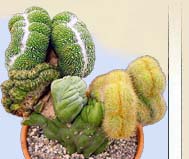Indoor
Floriculture

Leafy succulents
by Peter Lapshin

Cacti Library
'Cultivar' (V.Kalishev)

Moscow
Succulent Society

Moscow Indoor
Plant Club

Travels, nature,
botanical gardens

About Episcia
(Gesneriaceae)
 |
 |
CULTIVAR / КУЛЬТИВАР e-Magazine about exotic forms of Cactaceae ENGLISH / RUS-(Win1251) | |||
|
|
|

|
Photos by Peter Lapshin, Moscow, Russia
There is a wonderful corner in the Crimea - Nikitsky Botanical Garden which is located 6 km from Yalta, in half-dry subtropics with wet soft winter and hot dry summer. Founded in 1812 near the village of Nikita, it rapidly became recognized amid European botanical gardens. It occupies about 1100 ha (2700 Acres). The garden coast line extends for 6 km. The organization of the botanical institute has 12 scientific departments, the herbarium (one of the largest in Europe), the oldest Crimean library and a scientific museum, bordering with the wine tasting room.
The garden's collection includes more than 28,000 species of all kinds of plants. Trees and bushes from different subtropical regions of the world have been planted in parks in accordance with the decorative principle. That's why laurels and stone-pines from Mediterranean area, bamboos from Eastern Asia and sequoias from California all grow in immediate vicinity.
In summer Nikitsky Botanical Garden is buried in rich verdure of bushes, trees and flowers. Visitors are fascinated by flowering Silk Tree (Albizzia julibrissin), Oleander, Pomegranate, Crepe Myrtle (Lagerstroemia indica). In fall, when yellow foliage whirls in the clear air filled with the fragrance of flowering Wild Olive (Elaeagnus) and Osmanthus, various sorts of splendid chrysanthemums from many countries blossom there. Even in winter when the garden is briefly covered with snow, there are flowering Sweet box (Sarcococca), Wintersweet (Chimonanthus praecox), and Loquat (Eriobotrya japonica). In February catkins of Hazel (Corylus) open and yellowish haze of Cornus shimmers in the sun. More than ever the garden is beautiful in spring, when it is impossible to draw off a glance from amazing view of flowering trees: almond, peach, apricot, plum, cherry, fig, quince, and other cultural and decorative plants.
The scientists of the garden work on the problems of introduction and selection of plants and their optimal use in the economy. Nikitsky Botanical Garden has introduced into culture more than 360 species; during the last 80 years it has selected about 800 new sorts of plants, 250 of those have been zoned in different countries. The garden exchanges literature and seeds with 600 organizations in more than 100 countries and sustains scientific and business relationships with other botanical gardens and nurseries.
As an acknowledgement of the national importance and the global recognition, in 2000 Nikitsky Botanical Garden was promoted with the status of the National Scientific Center. The cactus greenhouse of the Nikitsky State Botanical Garden has a year-round open exposition of cacti and other succulents in open ground and containers. The cactus collection has 600 species, varieties and forms. The succulent collection is represented by almost 400 taxa. Various species of Yucca and Agave, as well as many cacti – Opuntias, Mammillarias, Echinocerei, Echinocacti, Acanthocalyciums, Echinopsis, Gymnocalyciums, Tephrocacti are planted in open ground. The greenhouse is directed by Olga I. Goncharova. Vera M. Novikova is the curator of the scientific collection. Here you can see the Internet site of the cactus greenhouse: www.lapshin.org/nikita. Currently it has a selection of about 200 pictures shot in the greenhouse in summer of 2000 and 2001. Also we invite you to visit the photo album of the southern coast of Crimea: www.lapshin.org/crimea, where you can see a number of photos of the park of Nikitsky Botanical Garden. Here you will find almost 200 photographs dated from 1995 to 2002.
|
| Cultivar e-magazin: Copyright (c) by Valery Kalishev, Chelyabinsk, Russia, since 2000. Design and hosting by Peter Lapshin, since 2002. Contacts: Peter Lapshin |
|
|